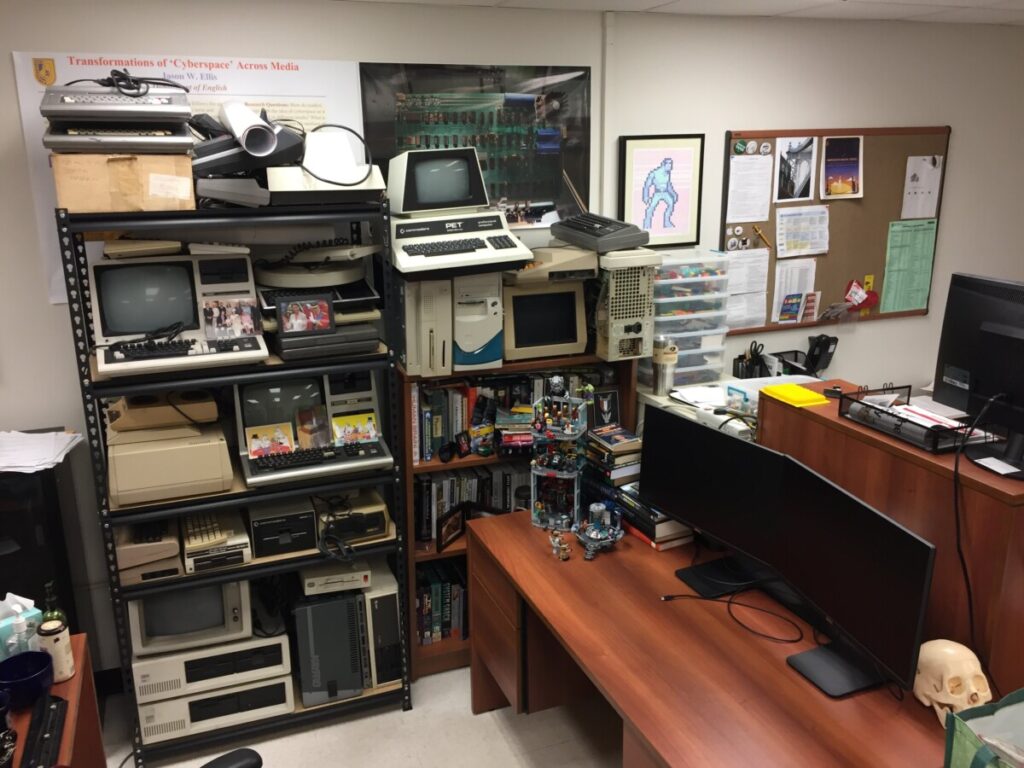For this week’s Weekly Writing assignment, I would like you to choose a different person from your team than the person who emailed me last week. This new team member should write an email to me (jellis at citytech.cuny.edu) and cc all the other team members. Use the subject, “ENG2575, Week 13 Update.” In the body of your email, write a professional message of about 250 words describing what your team has done over the past week to work on the project. This email should be written collaboratively through conversation (phone, Zoom, Google Hangouts) or text communication (text message, social media, etc.). It isn’t up one person to write this email. All team members are expected to say and contribute something to the email about what your team has been doing. For example: Did you have a meeting? Who is working on what? What research leads were found? What do you plan to do next? Don’t forget to include a salutation to open and a closing at the end. This is due by Wednesday, Nov. 25.
Author: Jason W. Ellis
Opportunity, Extra Credit for Attending and Writing About City Tech Events
This Thursday, Nov. 19, there are three big events hosted by City Tech that I wanted to let you all know about.
Also, you may earn extra credit that can take the place of a missed weekly writing assignment or be applied to a major project grade. To earn the extra credit, write an email to me that includes a 250-word or more summary of who you heard speak and what you learned from them. The events take place at different times of the day, so you can catch parts of each. You don’t have to stay for the whole event, but please invest enough time to get something out of the events that you do attend.
Even without the extra credit, I would like to encourage you all to take part in events–even virtual ones–at City Tech. I can speak from my own experience about how transformative these experiences can be.
Event 1: The Fifth Annual City Tech Science Fiction Symposium
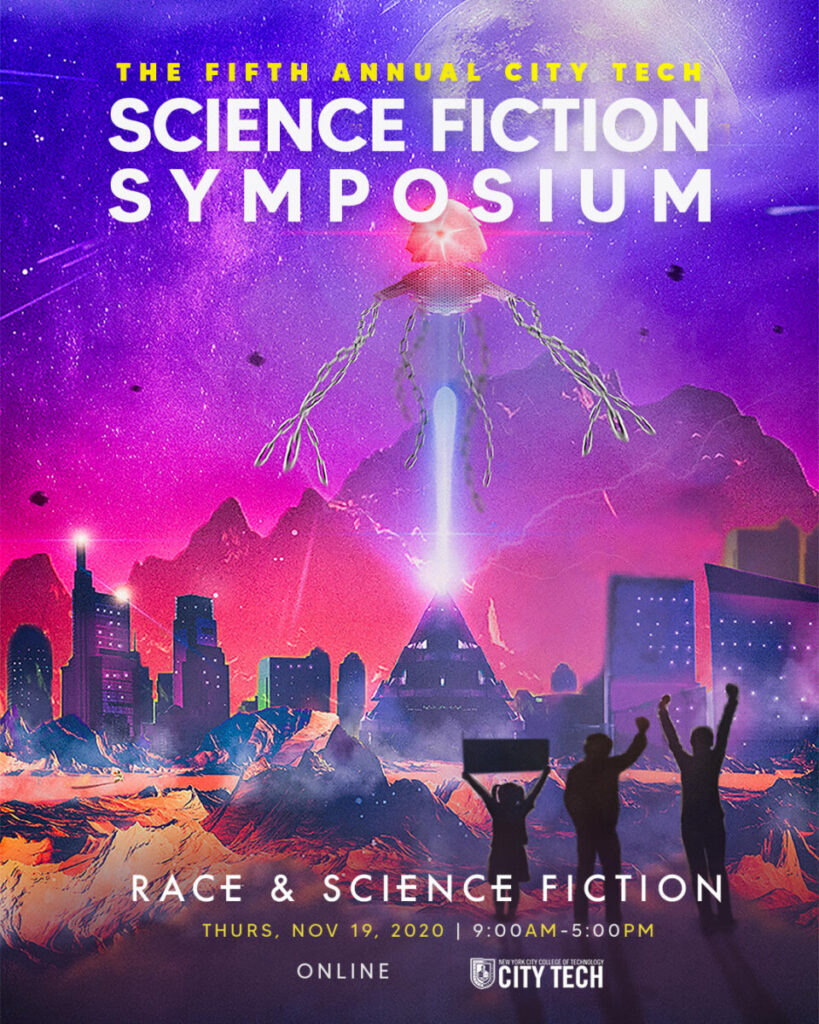
This is the big event that I help organize each year. We have Science Fiction writers, scholars, and students talking on the theme of “Race and Science Fiction.”
To join this virtual event, follow the instructions for registering to attend the Zoom Webinar at the top of the program located here.
Event 2: Conversation with New York Times Journalist Annie Correal
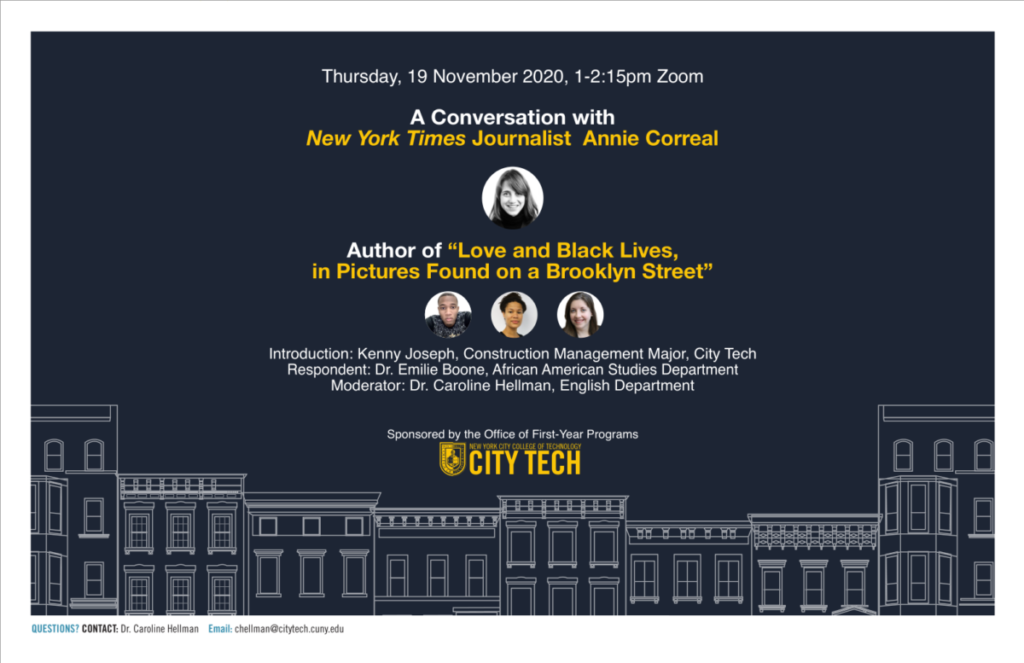
Please join us for New York Times journalist Annie Correal’s visit with the City Tech community. Correal will be discussing her trajectory as a writer and the story behind her 2017 article “Love and Black Lives, in Pictures Found on a Brooklyn Street.”
Thursday, November 19, at 1:00
Introduction: Mr. Kenny Joseph, Construction Management Major
Respondent: Dr. Emilie Boone, Art Historian, African American Studies Department
Moderator: Dr. Caroline Hellman, English Department
All are most welcome. Please share widely!
Join Zoom Meeting
https://us02web.zoom.us/j/81147763239?pwd=NFRtUllnOEpySDdvU2tyelB0eGFhdz09
Meeting ID: 811 4776 3239
Passcode: 680059
Event 3: 18th Annual City Tech Poster Session
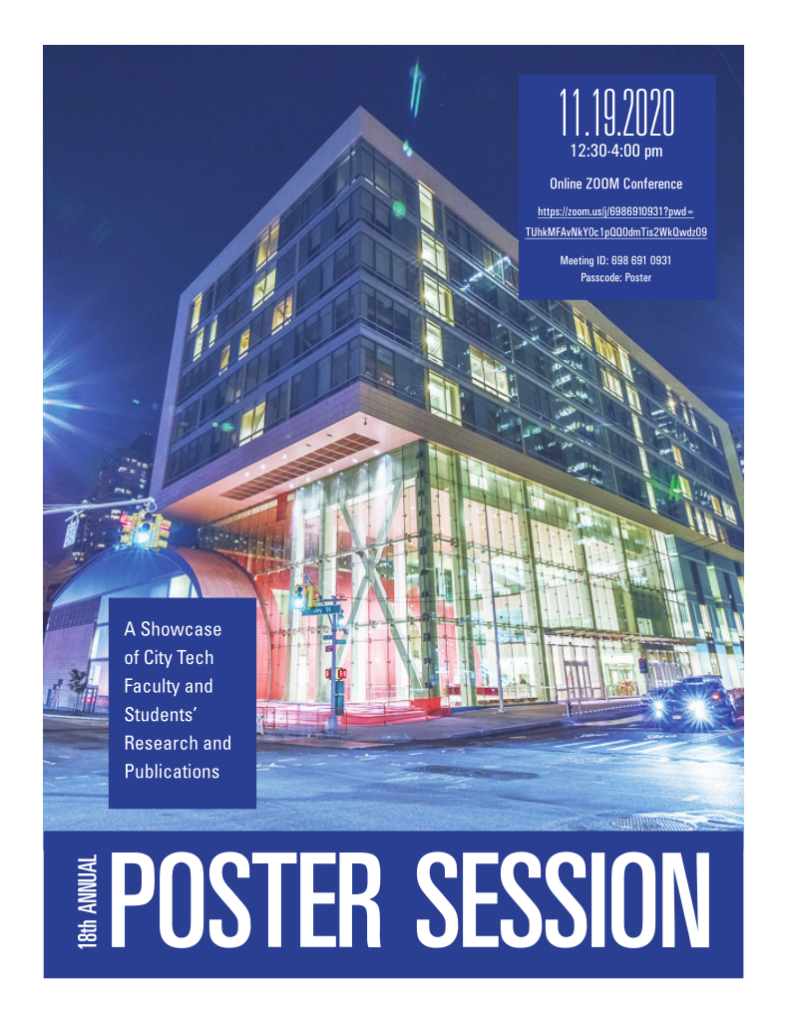
The 18th Annual City Tech Poster Session will held on November 19 from 12:30 pm to 4 pm
This year the Poster Session will be online via the ZOOM and OpenLab Platforms.
1) The opening of the Poster Session and one-minute Oral Presentations will start at 1 pm via ZOOM
Link: https://zoom.us/j/6986910931?pwd=TUhkMFAvNkY0c1pQQ0dmTis2WkQwdz09
Meeting ID: 698 691 0931
Passcode: Poster
2) Posters are accessible online starting November 19, 2020 via the OpenLab platform
https://openlab.citytech.cuny.edu/postersession2020/
Attached please find the Program and Book of Abstract of the 18th Poster Session.
Week 12, Office Hours, Wed., 11/11, 3:00pm-5:00pm
Week 12, Lecture
00:00 City Tech Writer Opportunity (Deadline extension to Nov. 30)
07:28 Using Doodle to Coordinate Team Meeting Times
23:35 Research Report
01:10:00 Weekly Writing Assignment
Week 12, Weekly Writing Assignment
For this week’s weekly writing assignment, your team should have emailed your topic to Professor Ellis beforehand.
Please watch this week’s lecture before proceeding.
Then, one team member should create a Google Doc and share it with all team members. See this week’s lecture for instructions on doing that. Team members will need to tell whoever takes point on this their Gmail/Google Drive email addresses.
Next, copy-and-paste the outline for your analytical research report that I provided below in the “Week 12, Project, Focusing on the Analytical Research Report” post below. This document is now where your team will write together–share research, write the report, format it, etc. You can write all at the same time or you can write at different times. Do not be afraid to edit and add to this document.
Finally, one team member should create a sharable link for viewing, again, refer to this week’s lecture for instructions on how to do this, and email that link to Prof. Ellis (jellis at citytech.cuny.edu). Be sure to cc your other team members on that email so that they know it has been sent.
Week 12, Project, Focusing on the Analytical Research Report
As discussed in the Week 12 lecture, your team needs to quickly choose a topic and begin working together to do the research and writing of your analytical research report. As I discuss in the lecture, this is a secondary research report, meaning it is based on research that you find done by others. You are not required to perform primary research or building/testing your topic on your own. This is the foundation for the rest of your collaborative project, which also includes a presentation, a website, and report on collaboration. I will discuss these latter parts next week.
With your analytical research report problem/topic identified, you can begin researching it with the library’s databases and books, periodicals like the New York Times, and the World Wide Web.
Evaluate and vet your sources so that you can account for their veracity, accuracy, credibility, etc.
To get started with writing your report together, check out this week’s Weekly Writing Assignment and the lecture. You will need the following outline:
Introduction (topic and why your report is important) Objectives of the research (what were you attempting to do?) Method (methodology–what kinds of research did you do, how did you do it, and why is the research sound?) Results (what did you find in your research? facts, quotes, figures, interviews, surveys, etc.) Discussion (how do you interpret your results? what story does your data tell us? results and discussion can be combined, but title this section appropriately if you do so) Conclusions (what conclusions do you draw from your results and discussion? what is the significance of what you discovered?) Recommendations (what do you think should be done to solve the research problem based on your research? this section is what all of your work is leading up to.)
Also, here are some resources and examples that I discussed in this week’s lecture to help you with writing and designing your analytical research report.
- Doodle (for finding meeting times for your team)
- Explanations of report parts (look under Primary Research Report, but remember you are writing a secondary research report)
- Example Student Research Report on Solar Panel Manufacturing and Waste
- Example Student Research Report on 5G
- Sample Research Report (note the layout and design)
Week 11, Office Hours, Cancelled
Dear all,
I’m afraid that I’m too ill to hold office hours today. Please email me with your questions and I’ll get back to you in the next couple of days. My email address is jellis at citytech.cuny.edu.
Best, Professor Ellis
Week 11, Lecture
Greetings, all!
Make sure you watch and take notes on this week’s lecture. It covers submitting your Instruction Manual Project and beginning the Collaborative Project. Scroll down our OpenLab Course Site for detailed instructions and screenshots to help you with those things, too. And, watch for my emails that will announce your new teams for the Collaborative Project.
Office hours will be Nov. 4 from 3:00-5:00pm. I’ll post a link above beforehand.
Week 11, Weekly Writing Assignment
To begin your team’s collaborative project, the first things that you will need to do are: 1) introduce yourselves, 2) provide other contact info, and 3) choose a topic for your research report.
To accomplish these things, I will start a new email thread for each collaborative project team (remember that these teams are different than your peer-review teams).
During this week, each team member should “Reply All” to my email to introduce yourself (including your major, hobbies, and interests, and make a note if you already know someone in your team–perhaps from the peer-review teams or another class), provide a phone number or suggest another way for your teammates to communicate besides email (Facebook, Whatsapp, etc.), and list three possible scientific or technical problems that you can potentially research for your team’s research report (for example, Moore’s Law, specific computer exploits like rowhammer or types of exploits like privilege escalation, etc.).
The purpose of your report is to present what you can learn about the problem and provide some solutions also based on your research, so think about these possible problems based on your studies and interests. Since you are all studying computers and/or electrical systems, I would recommend that you focus on problems related to that instead of problems not directly related, such as global warming. Coming up with three possible problems might require a little bit of library research, so don’t be afraid to check out the databases!
Now, after you and your teammates begin exchanging these emails, look at the possible problems for similarities or connections. Everyone should reply all to comment on the problems, generating ideas, and arguing for or against some of the options. After this discussion, a clear winner might emerge, or one team member can devise a vote of the top two or three candidates.
At this point or even before after you’ve made your first introductions via email, your team can decide if they would like to hold the rest of the conversation over email or another communication medium of your choice. For the weekly writing assignment, I will be looking for your first email with your three possible problem topics. The rest of the conversation is for your benefit to choose a topic for your project by Wednesday, 11/11.
After you’ve selected a problem for your research report, I would like one member of your team to send me an email and cc (carbon copy) all the other team members on that email. In the email, let me know what scientific or technical problem your team has selected. Email me your team’s topic by Wednesday, 11/11.
Watch this week’s lecture for more details and explanation. I will post it on Wednesday following our established schedule.
Week 11, Project, Beginning the Team-Based Collaborative Project
While you are finishing up your last individual project in the class, we are moving ahead to begin the team-based collaborative projects in the class.
Think of each of the following projects as part of an interconnected larger project. Each team member should contribute to each part, but individual team members may take the lead on one part versus the others depending on their skill set and interests. For example, one team member may take the lead on the research report and collect contributions from the other team members for the first draft, and another team member may take the lead on the presentation or the website.
These are the parts of the collaborative project from the syllabus:
- Collaborative: 4000-6000-Word Analytical Research Report, 20%
- Each team member contributes 1000-1500-word contribution to a 4000-6000-word analytical research report on a scientific or technological problem that demonstrates: 1) knowledge of the history and context of the problem, 2) knowledge of the causes and nature of the problem, 3) ideas for solving the problem, 4) the ability to explain the problem and offer possible solutions to a general audience, 5) the ability to integrate written work with the written work of a partner or partners in a coherent report, and 6) knowledge of proper research report format. At least six library-sourced citations must be included (non-library-sourced citations are encouraged, but they do not count toward the six library-sourced sources). Any outside sources cited should be documented according to APA format.
- Collaborative: Seven-to-Ten-Minute Oral Analytical Research Report on a Scientific or Technological Problem, 10%
- The goal of this part of the project is to transform your written report into an spoken presentation anchored by a PowerPoint or other visual presentation supplement. As a team, adapt and present your analytical research report as an oral presentation that demonstrates: 1) knowledge of oral presentation techniques and conventions, 2) the ability to organize a presentation effectively, 3) the ability to incorporate various media into the presentation, including appropriate computer software, 4) awareness of audience, 5) the ability to communicate the value of the product or service in clear spoken English, 6) the ability to answer audience questions, 7) the ability to collaborate productively with a partner or partners, and 8) the ability to explain the problem and offer possible solutions to a general audience.
- Collaborative: Website Advertising a Product or Service Responding to the Analytical Research Report and Oral Presentation, 10%
- The goal of this part of the collaborative project is to imagine a service or product that your team can offer that is related to your research report and oral presentation, both of which will be featured on the website in some way. The website should demonstrate: 1) knowledge of the product or service offered, of pertinent market forces, and of the potential customer base, 2) basic knowledge of web page design and composition, including appropriate software. The website will be based on your presentation and it is encouraged to be integrated into your presentation (perhaps to demonstrate how your team is promoting your product or service). All graphics, logos, design, and text must be created by your team.
- Collaborative: 500-Word Report on Collaboration, 10%
- During the collaborative project, the team as a whole needs to track and document their progress, challenges, and successes, and each individual delegated responsibilities needs to keep track of what they contribute to the project. As the last component of the collaborative project, write a brief report of 500-750 words reflecting on how the team worked together and what each individual team member contributed to the overall effort. Each team should submit only one report.
Another way to consider these interconnected projects is through the following illustration:
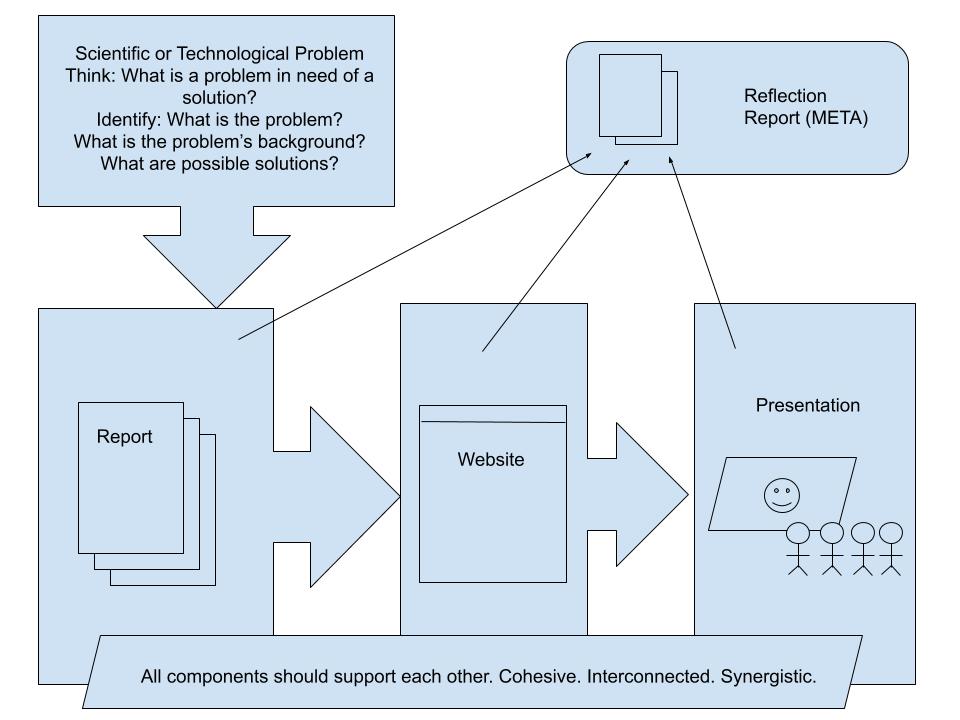
The main part of the collaborative project is the research report. It anchors everything else. It should be completed first and adapted or transformed for use in the other deliverables: the website and the presentation. The report, website, and presentation will be submitted on our OpenLab Course Site. Also, throughout the project, the team should keep track of the work that each person does and compile that into a reflection report that will be submitted via email to me after your collaborative project is completed.
To distribute the workload better, you will work in a new team of five or six persons. These teams are randomly assigned using a number list that I generated on random.org.
For your reference, I am including the teams below. I will get in touch with each team via email for this week’s weekly writing assignment.
Remember, don’t confuse these teams with your peer review teams on the first three projects in the course. If you are still working on individual projects and need peer review feedback, you should give and receive it with your peer review teams that you’ve already been working with.
Separately, you will begin working with this new team on the collaborative projects. There may be some overlap between your peer review team and the new collaborative teams–this was just by chance and not by design. In addition to reaching out to you by email, I will detail how I would like you to begin the project together in this week’s Weekly Writing Assignment, which I will post soon.
And, make sure that you all watch this week’s lecture and listen carefully to the details that I provide about the collaborative project.
Team 1 Barbu L. Tan Arias Romanowski Clarke Beauge Team 2 Requena Dominique Barbu T. Anny Anika Team 3 Abdulla Persaud Ferreira Patterson Htut Team 4 Andiappen Cifuentes Chan Pritom BK Team 5 Adeyemi Campbell Su Lin Bah

